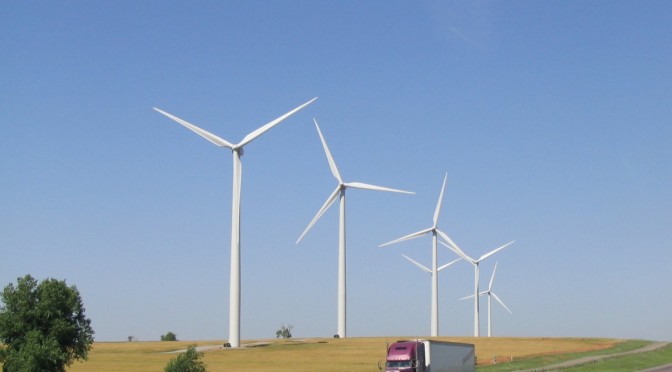Gov. Mary Fallin, Oklahoma State University officials and Oklahoma Gas and Electric Co. executives flipped ceremonial switches in Stillwater Friday to mark the completion of the Cowboy Wind Farm near Blackwell.
The wind power project has 26 wind turbines and a total capacity of almost 60 megawatts.
One megawatt can power about 250 homes.
The wind farm began commercial operations in January and will supply electricity to the OSU campus.
“This is a great day for Oklahoma State University and I think a great day for Oklahoma,” said OSU President Burns Hargis. “It’s very significant in our effort to be a more sustainable, green campus. As you know, our students have been very adamant about moving in that direction.”
OSU has been an aggressive adopter of energy-efficiency efforts. The university has saved more than $22 million through energy conservation efforts since 2007. OSU also has converted all its transit and community buses to compressed natural gas and added 90 new CNG vehicles to its fleet.
Fallin, an OSU alumna, said she’s asked other state universities to follow OSU’s lead in energy efficiency. The governor and Legislature last year directed state agencies to reduce their energy consumption 20 percent by 2022, with estimated savings of up to $300 million for Oklahoma taxpayers.
“We’re using all types of energy production in our state, but wind power and renewable energy are certainly key components,” Fallin said. “Oklahoma has some of the best wind resources in the whole nation.”
Oklahoma now ranks sixth in the nation for wind power capacity, up from eighth place in 2011, according to federal and industry statistics.
Pete Delaney, chairman, president and CEO of OGE Energy Corp., said the addition of the Cowboy Wind Farm means renewable energy now represents about 12 percent of OG&E’s generating capacity. The utility has about 840 megawatts of wind capacity across seven wind farms in western and northwestern Oklahoma.
“Wind is an important part of our generation portfolio,” Delaney said. “We do believe in a diverse portfolio: wind, natural gas and coal. We believe for the long term, we need to have it all to keep a reliable and affordable supply for our country.”
Delaney said the Cowboy Wind Farm is just the latest in a series of partnerships between OG&E and OSU. The utility funds scholarships and professorships. OSU’s Oklahoma City campus offers the state’s only four-year wind technician program.
We’re using all types of energy production in our state, but wind power and renewable energy are certainly key components.”
Rama Ramakumar, an electrical engineering professor and director of the OSU Engineering Energy Laboratory, said the wind farm is an affirmation of renewable energy research. Ramakumar, who came to OSU in 1967, developed some of the early mathematical models for variable-speed wind generation.
“We are happy that what we advocated 40 years ago has come to fruition,” Ramakumar said. “For a professor or anybody in teaching, the idea is to sow seeds that will grow later on, and that’s absolutely true in this case. The students are more and more interested, and my classes have more students than ever before. They’re wanting to learn about sustainability and wind energy.”
OSU began exploring alternatives to its customer agreement with OG&E after finding its aging cogeneration plant wouldn’t be sufficient to meet future energy needs. The university and OG&E agreed to renegotiate a power contract that expired in 2017.
Under the new contract, OSU will purchase its electricity from OG&E for the next 20 years, with some of the power coming from the Cowboy Wind Farm. OG&E also will build a new substation on the OSU campus. The Oklahoma Corporation Commission approved the contract in March 2012.
The university plans to permanently retire its 1940s-era cogeneration power plant, which can supply up to 8 percent of the campus’ electricity needs, but at a higher cost than OG&E electricity. OSU will keep its steam and chiller plants for heating and cooling needs.
The OSU wind farm project generates renewable energy credits at the rate of one credit for each 1,000 kilowatt-hour block of electricity. The credits can be sold or traded and are proof that power was generated from a renewable source.
With the addition of the wind farm and associated renewable energy credits, OSU has surged to fifth place nationally in the Environmental Protection Agency’s Green Power Partnership rankings of colleges and universities. About 67 percent of OSU’s electricity will now qualify for renewable energy credits.
The University of Oklahoma is in sixth place on the EPA list, with 56 percent of its electricity qualifying for renewable energy credits. OU was EPA’s Green Power Partner of the Year in 2012, along with the city of Austin, Texas; Microsoft Corp.; and Hilton Worldwide.


